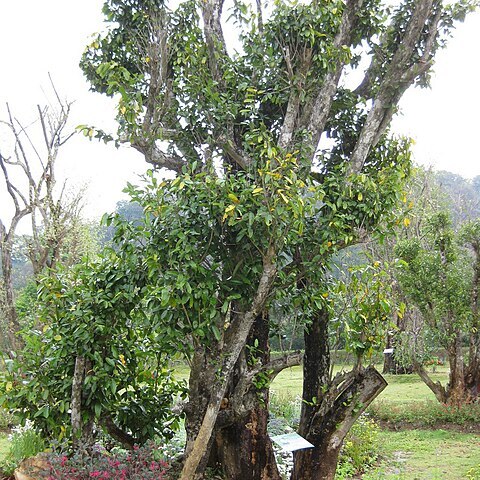Trees or shrubs. Leaves simple, alternate, without stipules, petiolate; leaf blade usually yellow-green when dry, leathery, veinlets reticulate, margin entire. Flowers bisexual, zygomorphic, shortly pedicellate, in racemes or panicles, axillary or terminal; bracts and bracteoles present. Sepals 5, imbricate, inner 2 slightly larger. Petals 5, differing slightly in size, imbricate, sometimes unguiculate, free, keel without apical appendages. Stamens 8; filaments free or 2-4 adherent at base of ovary, other 4-6 adherent at base of petals, ± slightly inflated, pubescent; anthers introrse, usually piliferous at base. Disk annular, fleshy, shorter than ovary. Ovary superior; carpels 2, connate, stalked, 1-loculed, glabrous or piliferous, placentation parietal; ovules 2 to numerous, anatropous; style 1, hairy; stigma capitate, shallowly lobed. Fruit a drupe, globose, fibrous-fleshy when dry, 1-loculed. Seed usually 1; seed coat membranous; caruncle absent; endosperm absent.
Trees or (not in Australia) shrubs. Leaves alternate, simple, usually coriaceous, petiolate. Stipules absent or represented by nodal glands. Inflorescences axillary or terminal racemes, sometimes paniculate, bracteate and bracteolate. Flowers bisexual, usually zygomorphic, hypogynous. Calyx of 5 free sepals, imbricate (quincuncial), the inner usually longer. Corolla of 5 free petals, imbricate, often clawed, unequal or ± similar, the lowest ± folded forming a keel. Stamens 8; filaments free or (not in Australia) basally connate; anthers basifixed, 2-locular, dehiscing by longitudinal slits. Disc intrastaminal. Ovary superior, stipitate, syncarpous with 2 carpels, 1-locular; placentation parietal; ovules 2–many, anatropous; style terminal; stigma capitate or 2-lobed. Fruit indehiscent or irregularly splitting, dry to subfleshy. Seeds 1–many; embryo large; endosperm absent.

